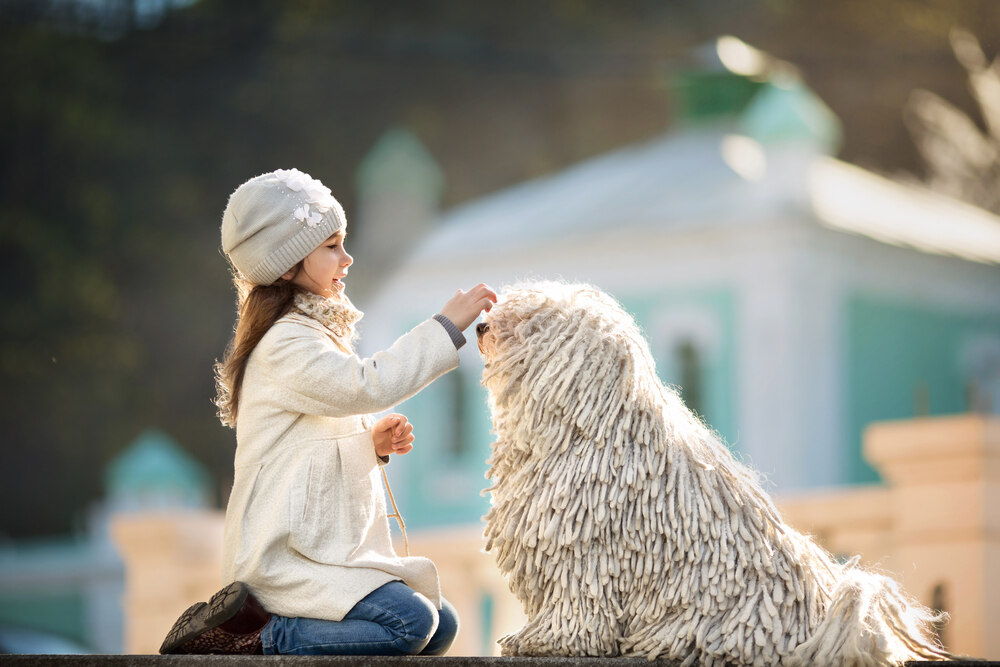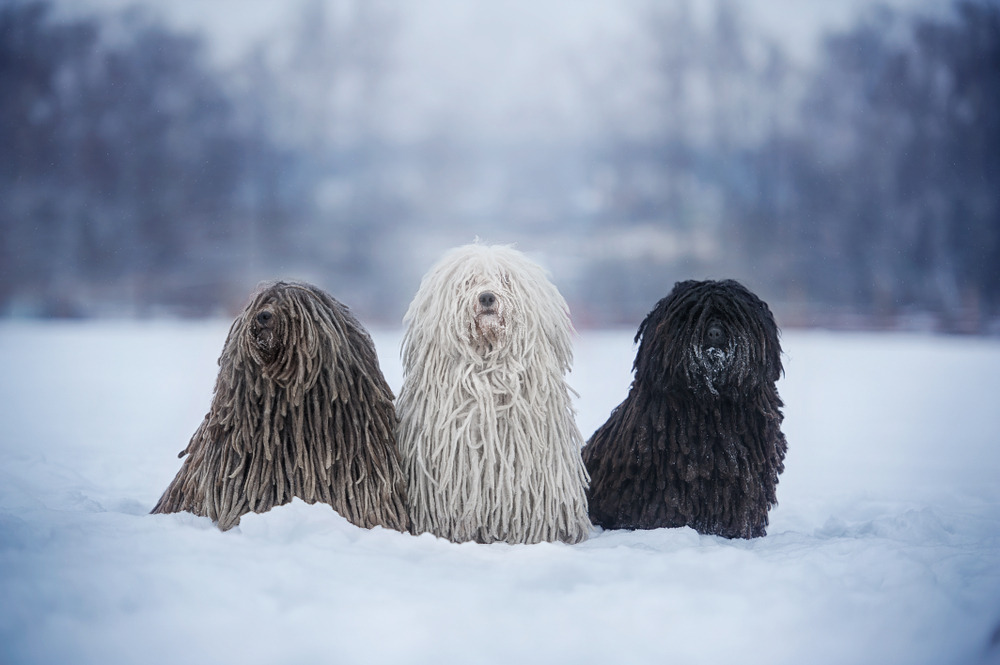In this article
View 8 More +Once you see the Puli dog breed for the first time, you’ll never forget them. Their corded fur is as unique as it gets, and it is the perfect match for their unique personalities. They’re considered hypoallergenic dogs (although no dog is truly hypoallergenic) that are incredibly adorable but also come with their own challenges when caring for them. Let’s learn more about the Puli dog, including their temperament, appearance, food and exercise requirements, and more, down below.
Breed Overview
Height:
16–17 inches
Weight:
25–35 pounds
Lifespan:
10–15 years
Colors:
Black, silver, white, rust, brindle, cream, or brown
Suitable for:
Single-pet homes, those looking for a low-shedding dog, and experienced pet owners
Temperament:
Loyal, intelligent, easy to train, wary of other pets and people
The Puli is an ancient Hungarian breed that has evolved quite a bit over the years, and today, their big personalities match their unique appearance, even if they’re not the largest dogs. They are as loving as any dog can be, but they’re not always the best with kids and other pets.
Still, their exercise needs are manageable, and with how eager they are to please their owners, you can train them to perform all sorts of commands.
Puli Characteristics

Puli Puppies

While the Puli has enjoyed official recognition by the American Kennel Club (AKC) since 1936, they’re still a rare and unique dog breed in the United States. While there’s no official reason for why these dogs are still rare in the United States, it’s likely because they don’t always get along the best with smaller children and other pets.
Still, while the Puli is far from the most common dog breed, you should be able to find a breeder with Puli puppies that is semi-close to you no matter where you live. Just ensure you’re finding a reputable breeder that provides references and health guarantees, and that allows you to inspect the facilities so you’re not supporting a puppy mill—even if you need to travel a little farther to get there.

Temperament & Intelligence of the Puli
There’s no doubting the overall intelligence of a Puli, and they’re incredibly loving to their owners. With proper training and socialization, the Puli can be an amazingly loving pooch that gets along great with everyone in the home. They love pleasing their owners and want as much attention as you’re willing to give them.
Are These Dogs Good for Families? 🏡
If you’re looking for the ideal family companion, the Puli might not be what you’re looking for. With proper socialization, you can get them to get along with kids, but they’re simply not as great with them as other breeds.
In addition, their smaller size means you need to be especially careful with them around smaller children who are learning to walk. While they might not mean to fall on them, they might, which can lead to serious injuries to your pup or have them lash out and nip.

Does This Breed Get Along With Other Pets? 😽
Just like how the Puli doesn’t always get along the best with kids, they need a little extra socialization and attention if you want to keep them around other pets, and this is partially because of their engrained herding instinct. Proper socialization can help with this quite a bit, but we highly recommend a meet and greet before bringing them into a multi-pet home.

Things to Know When Owning a Puli:
Food & Diet Requirements 🦴
The Puli isn’t the largest dog in the world, but they’re not the smallest either. Smaller Pulis needs about 1¾ cup of high-quality, complete and balanced kibble daily, while larger Pulis need about 2 cups daily. However, this will largely depend on their size and how much exercise they get per day. If you ever need clarity on what or how much to feed your Puli, reach out to your vet for advice.
Exercise 🐕
While Pulis love having jobs to keep them busy, they’re not dogs that need non-stop action. Between their moderate need for exercise and smaller size, meeting their exercise needs isn’t overly challenging. You’ll still need to take them out for two walks daily, and each walk should last at least 15 minutes, but preferably more from there, they’ll enjoy a fenced-in yard where they can run around, but it’s not an absolute necessity so long as they are getting 30 to 60 minutes of exercise daily.

Training 🦮
One area where the Puli dog breed really thrives is during training. They need consistency with their training schedule, but if you give them one training session daily that lasts about 15 minutes, you can train them to complete all sorts of tasks.
Stick solely with positive reinforcement and find a treat they really like to keep their attention on you throughout the training session.
If you plan on keeping your Puli around children or other pets, they’ll need a little extra socialization and training, and once again, consistency is critical.
Grooming ✂️
Since the Puli doesn’t shed much, you might think it’s easy to keep up with their grooming needs—think again. They have thick coats with a distinct appearance, and they need you to brush them out daily. However, their coats can be kept corded, clipped, or brushed. However, you won’t need to worry much about this until they are about 8 to 10 months old until their undercoat starts to come in.
Many people choose to allow their coats to cord, which essentially are organized mats that tighten over time. Once these come in, all they require is regular brushing and separating the cords, unless you choose to go with a different coat style.
In addition, you’ll need to brush their teeth daily to keep up with their oral hygiene, and keep an eye on their nails and trim them as needed.

Health and Conditions 🏥
While every dog breed has some health issues you need to worry about, for the most part, the Puli is a healthy breed. This is especially true if you get your Puli from a reputable breeder.
You also need to give them frequent visits to the vet for routine checkups, so you can catch and correct issues while they’re still small.
- Cataracts
- Dental problems
- Progressive retinal atrophy
- Deafness
- Canine hip dysplasia
- Obesity
- Diabetes

Male vs. Female
Like most dogs, there isn’t much of a difference between a male and female Puli, with one notable exception: their size. Males tend to stand a bit larger than females. They’re generally about an inch taller and weigh about 5 to 10 pounds more.
Other than the difference in size, they’re almost identical, with the majority of the differences coming down to the individual personality of each dog.

3 Little-Known Facts About the Puli
1. Their Coats Protect Them From the Cold and Heat
The Puli has a unique coat that helps insulate them from the frigid cold and intense heat. It looks unique, and it’s highly functional.
2. They Date Back Over 6,500 Years
There are old dog breeds, then there’s the Puli. They date back over 6,500 years, with roots in Hungary, China, India, and Tibet. While they’ve never been the most popular dog in the world, they’ve certainly been around for a long time.
3. You Need to Dry Them Thoroughly
Not only does the Puli look like a mop, but they absorb water and moisture like a mop too. If you don’t dry the coat out completely, it can start to mildew and rot, which isn’t good for them or you!

Final Thoughts
While the Puli might look unique, that doesn’t mean they’re the perfect fit for everyone. Their strong herding instincts mean you should proceed with caution if you have smaller pets or younger children.
They’re the perfect dog for many people, but it’s essential they find their way to the right home; otherwise, they can quickly turn into a nightmare. But even if you don’t plan on getting one yourself, they’re still an awesome breed that’s well worth a look!
Featured Image Credit: BORINA OLGA, Shutterstock


















